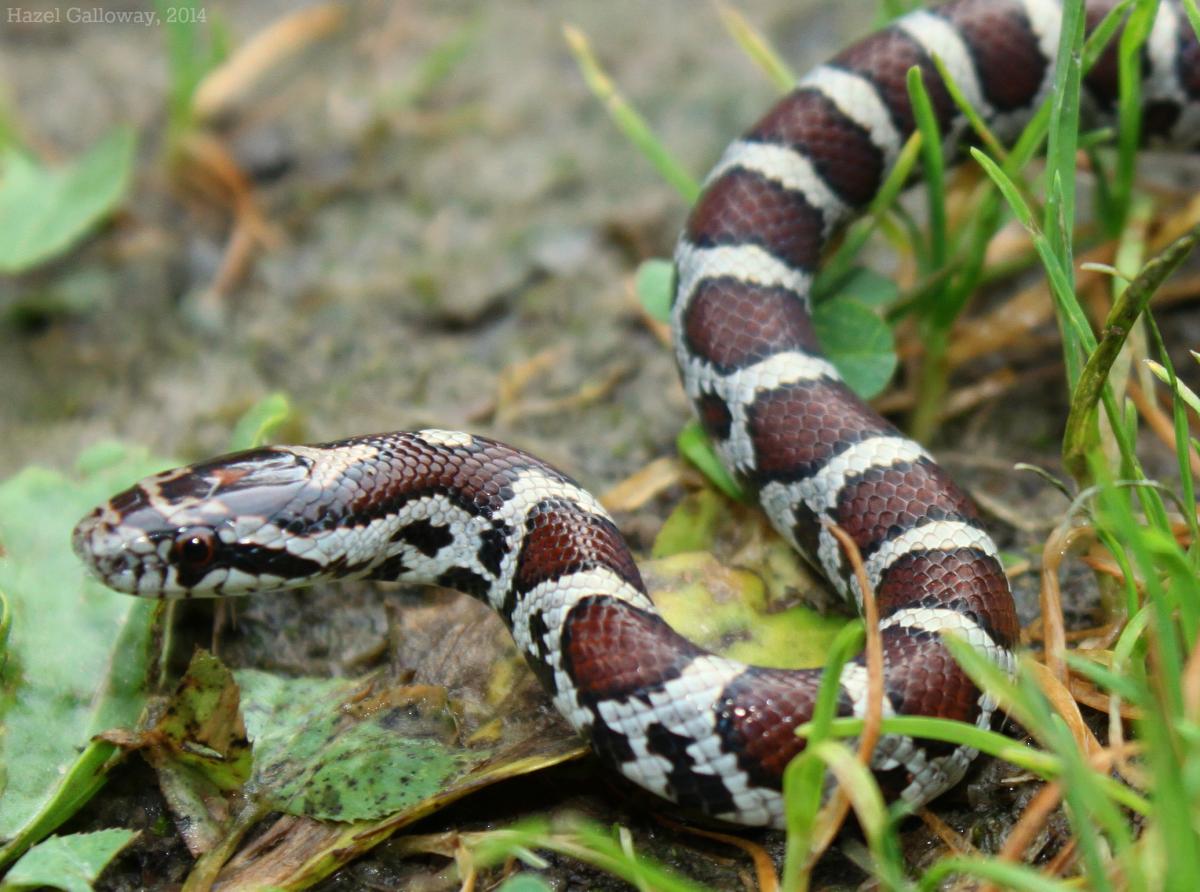 The harmless milk snake is the victim of a range of popular misconceptions. It derives its common name from the myth that it feeds on milk sucked from cow udders (a total anatomical impossibility). It also suffers from a resemblance to the venomous copperhead and the colloquial name “adder,” neither of which improve its reputation among people unfamiliar with snakes. Although milk snakes are nonpoisonous, the striking similarity not only to copperheads but also, in some subspecies, to venomous coral snakes is likely Batesian mimicry. Although they do not resemble rattlesnakes, milk snakes are known to vibrate their tails in the leaves when threatened, thus deterring predators by evoking yet another snake more perilous than itself.
The harmless milk snake is the victim of a range of popular misconceptions. It derives its common name from the myth that it feeds on milk sucked from cow udders (a total anatomical impossibility). It also suffers from a resemblance to the venomous copperhead and the colloquial name “adder,” neither of which improve its reputation among people unfamiliar with snakes. Although milk snakes are nonpoisonous, the striking similarity not only to copperheads but also, in some subspecies, to venomous coral snakes is likely Batesian mimicry. Although they do not resemble rattlesnakes, milk snakes are known to vibrate their tails in the leaves when threatened, thus deterring predators by evoking yet another snake more perilous than itself.
L. t. triangulum is a long, slender snake, usually measuring 61-90 cm when mature, although they can reach lengths as great as 132 cm. They are grey or tan in color and marked by 3 rows of brown or reddish brown, black-bordered blotches patterned down the length of the body. The large middorsal spots alternate in position with the smaller, lateral darker patches. They usually (but not always) have a Y or V-shaped light patch just behind their head. Milk snakes’ bellies have an irregular black-and-white checkerboard pattern. Copperheads, while indeed superficially similar, have a largely unmarked head and only a single row of dark blotches down their backs. Two important traits can distinguish milk snakes from similar-looking water snakes; namely, the shape of their scales (water snakes’ are keeled, milk snakes’ are smooth) and the scale on their belly known as the anal plate (water snakes’ are divided, milk snakes’ are single). Rat snakes and racers, which have blotched patterning when young, also have divided anal plates.
Although typically solitary in their habits, milk snakes overwinter in hibernacula with many other individuals. Just before hibernation in the autumn, they can be found basking in the sun in large groups. They likely mate while still in the hibernacula, and females lay clutches of 2-17 elliptical eggs in warm, humid areas (often rotting logs or vegetation) shortly after emerging in April-May. When the eggs hatch in about a month, the young that emerge are already 14-28 cm long and independent. They are often more brightly colored at birth, with black-lined reddish or orangish blotches; however, the color tends to fade by the time they reach maturity at 3-4 years. Little is known about their lifespan in the wild, but it is likely to be long. One snake captured in adulthood survived another 21 years in captivity.
Milk snakes were likely the associated with livestock because of their proclivity for spending time in barns, where rodents are plentiful. They also are known to eat birds, bird eggs, lizards, and other snakes, including rattlesnakes. They kill their prey by constriction, squeezing the unfortunate animal until it suffocates. The juveniles seem to feed mainly on other young snakes.
This juvenile was found under a snakeboard near the pond by the field herpetology class. While they are widespread throughout North America east of the Rocky Mountains, this appears to be the first and only milk snake ever found on the mountain.
Hazel Galloway
Sources:
- A Field Guide to Reptiles and Amphibians: Eastern and Central North America. 3rd Edition. Boston: Houghton Mifflin Company,1998.
- http://animaldiversity.ummz.umich.edu/accounts/Lampropeltis_triangulum/
- http://www.dgif.virginia.gov/wildlife/information/?s=030029



